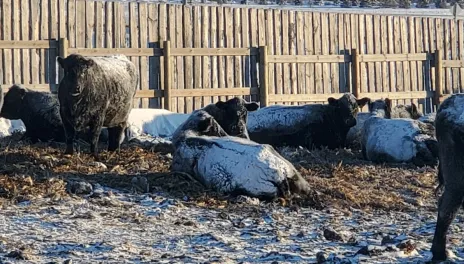Extreme Cold Weather is Affecting Cows
A warm sun shining on black cows is a brief reprieve from cold winter nights, and the Carrington area has had its share of cold weather this winter. NDAWN (North Dakota Agricultural Weather Network) data at Carrington for the past 90 days had 20 days of low temperatures between -10 and -20 F and 11 days with lows between -20 and -30 F. When wind and temperature were combined, there were 43 days with windchills lower than -20. Windchills colder than -40 occurred on 10 days.
The USDA Livestock Indemnity Program considers -40 windchill as extreme cold for mature cattle. Cows can handle a few days of extreme cold weather without requiring much change in management. However, this winter, producers and cows are being caught in extended periods of cold weather. Cows in great condition (body condition score 6 to 8) have some good things going for them. Extra body fat provides some insulation from the cold and provides a source of energy to metabolize and generate warmth. Cows in great condition can survive cold weather.
Last year’s drought yielded mixed results when considering body condition scores. Some cows entered winter in good condition while others did not. Unfortunately, cows in thin condition are extremely challenged this winter. Thin cows in extreme cold may succumb to the elements. That’s the reality for winter. Older cows and thin younger cows are most susceptible to extreme cold. New born calves are very susceptible to extreme cold with frozen ears, tail and feet inflicting the survivors. Feedlot cattle are stressed by extreme cold with poor performance evident in lower average daily gains and poorer feed conversions.
It’s very difficult to increase the body condition of cow in a few days. Raising body condition score by even one point (about 80 pounds body weight) would take almost a month at 3 pounds per day gain. That would require a ration containing at least 50% grain. In other words, the ration should be at least 70% TDN or a 48 Mcal/cwt NEg ration.
Most forages don’t contain 70% TDN. Corn silage maybe the exception, but good silage comes from corn plants with well-developed ears containing grain. Silage can be fed during extreme cold, but silage should not freeze before cattle eat it.
While low quality forages are typically a major part of a cow’s winter diet, additional energy supplementation is needed during extreme cold. Grain or co-products (like distillers grains or wheat middlings) are usually the cheapest source for energy supplementation. Feeding extra hay or straw may satisfy the appetite of a hungry cow, but rarely provides enough energy to offset the increased energy needs created by extreme cold.
Immediate relief to extreme cold is provided by warm shelter, windbreaks, bedding, and adequate feed and water. Long term relief revolves around keeping cows in great condition.
Karl Hoppe, Ph. D.
Karl.Hoppe@ndsu.edu
Extension Livestock Specialist
